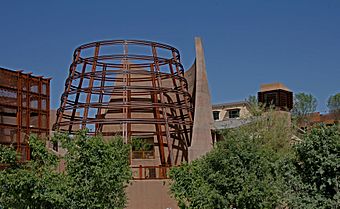Las Vegas Springs facts for kids
Quick facts for kids |
|
|
Las Vegas Springs
|
|

The Desert Living Center rotunda at the Springs Preserve
|
|
| Location | Las Vegas, Nevada |
|---|---|
| NRHP reference No. | 78001719 |
| Added to NRHP | December 14, 1978 |
The Las Vegas Springs is a special place where water naturally comes out of the ground, creating a green oasis in the desert. This kind of wet, grassy area is sometimes called a cienega. For over 15,000 years, these natural springs have bubbled up, forming green meadows. These meadows were so green that Mexican explorers called the area "las vegas," which means "the meadows" in Spanish.
These bubbling springs were a vital source of water for Native American people who lived here at least 5,000 years ago. The Las Vegas Springs are known as The Birthplace of Las Vegas because they provided life-giving water. They also helped travelers on the Old Spanish Trail and Mormons who came to settle in the West. The water for these springs comes from a huge underground water supply called the Las Vegas aquifer.
The springs are now part of the Las Vegas Springs Preserve. This area was once home to three springs that flowed into two big pools of water. It was a historic meeting place for pioneers, Native Americans, and early settlers in the Las Vegas Valley. In 1905, the springs provided water for the growing town and its railroad. However, as more pipelines were built and wells were drilled, the underground water level dropped. Because of this, the springs stopped flowing to the surface in 1962. Today, the site is being carefully restored to protect its important historical and archaeological remains.
Now, the Las Vegas Springs Preserve covers 180 acres of historic land. It is located just west of Downtown Las Vegas and is open for everyone to visit and explore.
A Look Back in Time
The first non-Native American person to cross the Las Vegas Springs was Raphael Rivera in 1829. He was a Mexican scout for an expedition led by Antonio Armijo. This group was exploring the Old Spanish Trail, which connected New Mexico and California. Later, in 1844, American explorers John C. Fremont and Kit Carson also camped at the springs.
The springs stopped flowing to the surface in 1962. This happened because the water table (the level of water underground) dropped. More water was being pumped out to meet the needs of a growing population than was being replaced by rainfall and melting snow.
People using private wells without limits and wasting water also contributed to the underground water supply running low. Because of this, the Las Vegas Land and Water Company had to drill a well, called 'Well No. 1,' in 1923 to get enough water for the city.
The Las Vegas Springs and the structures built around them were added to the National Register of Historic Places in 1978. They are also marked as Nevada Historical Marker 40.

